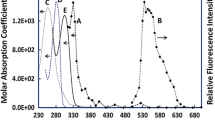Conclusions
-
1.
The rate constants of quenching of the triplet state of benzanthrone and phenazine by substituted N,Ndimethylanilines, anilines, and phenols in n-heptane and CH3CN were determined by the method of flash photolysis.
-
2.
The capacity of quenching agents to deactivate the triplet state in heptane at the same ionization potential increases as the acidity increases in the order N,N-dimethylanilines > anilines > phenols.
-
3.
Total electron transfer is the most probable mechanism of quenching by N,N-dimethylanilines. Quenching by anilines and phenols is due to intercombination conversion in an exciplex with charge transfer and hydrogen bonding.
Similar content being viewed by others
Literature cited
P. P. Levin, A. P. Darmanyan, V. A. Kuz'min, A. Z. Yankelevich, and V. M. Kuznets, Izv. Akad. Nauk SSSR, Ser. Khim., 2744 (1980).
C. G. Schaeffer and K. S. Peters, J. Am. Chem. Soc.,102, 7566 (1980).
N. Periasami and H. Linschitz, Chem. Phys. Lett.,64, 281 (1979).
R. Egdell, J. C. Green, and C. N. R. Rao, Chem. Phys. Lett.,33, 600 (1975).
J. P. Maier and D. W. Turner, J. Chem. Soc. Faraday Trans. 2,69, 521 (1973).
H. Goetz, H. Hartan, H. Juds, F. Marschner, and H. Pohle, Liebigs Ann. Chem., 566 (1977).
N. T. Kobayashi and S. Nagakura, Bull. Chem. Soc. Jpn.,47, 2563 (1974).
E. T. Seo, R. F. Nelson, J. M. Fritsch, L. S. Marcoux, D. W. Leedy, and R. N. Adams, J. Am. Chem. Soc.,88, 3498 (1966).
S. Wawzonek and T. W. McIntyre, J. Electrochem. Soc.,114, 1025 (1967).
V. A. Kuz'min, I. V. Renge, and Yu. E. Borisevich, Chem. Phys. Lett.,70, 257 (1980).
I. V. Renge, V. A. Kuz'min, A. F. Mironov, and Yu. E. Borisevich, Dokl. Akad. Nauk SSSR,236, 54 (1982).
S. Arimitsu, H. Masuhara, N. Mataga, and H. Tsubomura, J. Phys. Chem.,79, 1255 (1975).
V. V. Osipov, M. N. Usacheva, and I. I. Dilung, Dokl. Akad. Nauk SSSR,254, 407 (1980).
J. D. Cox and G. Pilcher, Thermochemistry of Organic and Organometallic Compounds, Academic Press, London (1970).
P. Kebarle and T. B. McMahon, J. Am. Chem. Soc.,99, 2222 (1977).
J. E. Bartmess, J. A. Scott, and R. T. McIver, J. Am. Chem. Soc.,101, 6046 (1979).
C. Laurence, G. Guiheneuf, and B. Wojtkowiak, J. Am. Chem. Soc.,101, 4793 (1979).
A. K. Chibisov, Khim. Vys. Energ.,10, 1 (1976).
V. M. Belobrov and E. V. Titov, Problems in Physical-Organic Chemistry [in Russian], Naukova Dumka, Kiev (1978), p. 57.
Author information
Authors and Affiliations
Additional information
Translated from Izvestiya Akademii Nauk SSSR, Seriya Khimicheskaya, No. 9, pp. 2009–2014, September, 1982.
Rights and permissions
About this article
Cite this article
Kuz'min, V.A., Renge, I.V. & Borisevich, Y.E. Flash photolysis study of quenching of triplet states of aromatic compounds by electron donors. Russ Chem Bull 31, 1774–1778 (1982). https://doi.org/10.1007/BF00952374
Received:
Issue Date:
DOI: https://doi.org/10.1007/BF00952374




